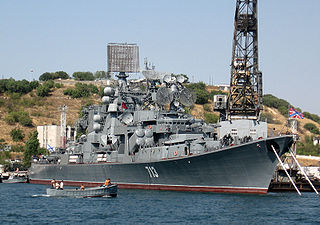
HMS Gurkha (F122) was a Tribal-class frigate of the Royal Navy. She was named after an ethnic group located in Nepal, and who continue to serve in the British Army. She was sold to the Indonesian Navy in 1984 and renamed KRI Wilhelmus Zakarias Yohannes (332).

HMS Zulu (F124) was a Tribal-class frigate of the Royal Navy in service from 1964 to 1984. She was the third ship bearing the name of HMS Zulu, having been named after an ethnic group located primarily in KwaZulu-Natal Province, South Africa. Zulu was built by Alexander Stephen and Sons, of Govan. She was launched on 3 July 1962 and commissioned on 17 April 1964.

The Moskva class, Soviet designation Project 1123 Kondor (condor) and S-703Project 1123M Kiev, was the first class of operational aircraft carriers built by the Soviet Union for the Soviet Navy.

The Kara class, Soviet designation Project 1134B Berkut B, was a class of guided missile cruisers built in the Soviet Union for the Soviet Navy. The NATO lists the class as "cruisers" mainly due to the Metel anti-ship missile system capable of striking not only submarines, but also surface vessels.

The Petya class was the NATO reporting name for a class of light frigates designed in the 1950s and built for the Soviet Navy in the 1960s. The Soviet designation was "Storozhevoi Korabl`" Project 159.

Retivyy was a Project 1135 Burevestnik-class Guard Ship or Krivak-class frigate. With an armament based around the URPK-4 Metel anti-submarine missile system, the vessel served with the Pacific Fleet of the Soviet and Russian Navies. The ship was launched on 14 August 1976 by A.A. Zhdanov in Leningrad, the second of the class built by the shipyard. After joining the fleet, the vessel took part in the search for the crew of the crashed Lockheed P-3 Orion AF 586. In 1981, the vessel sailed as part of a task force along the west coast of the United States to test and measure American defences. Decommissioned on 4 August 1995, the vessel was subsequently sold to a South Korean company to be broken up.

Admiral Isakov was a Kresta II-class cruiser of the Soviet Navy and briefly of the Russian Navy, named for Soviet admiral Ivan Isakov. The second ship of her class, she served mostly during the Cold War from her commissioning in 1970.

Sposobny was a Project 61 destroyer of the Soviet Navy, which briefly became part of the Russian Navy. The ship served during the Cold War from 1971 to 1989.

Tashkent was the sixth ship of the Kara-class cruisers of the Soviet Navy. She was launched in November 1975 and commissioned in December 1977 at the 61 Communards Shipyard. After the fall of the USSR, she was scrapped in India in 1994.

Tallinn was the seventh ship of the Kara-class cruisers of the Soviet Navy. She was launched in November 1976 and commissioned in December 1979 at the 61 Communards Shipyard. She was renamed Vladivostok In 1992. After the fall of the USSR, she was scrapped in India in May 1996.

Admiral Zakharov was a Udaloy-class destroyer of the Russian Navy. She was named after admiral Mikhail Zakharov.

Komsomolets Ukrainy was the lead ship of Kashin-class destroyer of the Soviet Navy.

Provorny was a Kashin-class destroyer of the Soviet Navy.

Skory was a Kashin-class destroyer of the Soviet Navy.
Krasny Krym was a Kashin-class destroyer of the Soviet Navy.

Soobrazitelny was a Kashin-class destroyer of the Soviet Navy.

Strogy was a Kashin-class destroyer of the Soviet Navy.

Stroyny was a Kashin-class destroyer of the Soviet Navy.
Smyshlyony was a Kashin-class destroyer of the Soviet Navy.

Sderzhanny was a Kashin-class destroyer of the Soviet Navy.























